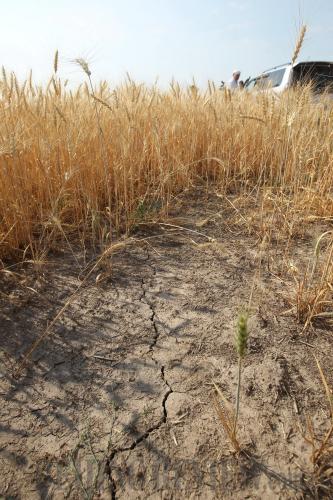|
 |
|
THIRSTY LAND: The photo shows drought-affected farmland in Lyscovo, Russia's Nizhny Novgorod Oblast, on July 22. There had been no rain in the area for more than two months (LU JINBO) |
Food security
Climbing grain prices will undoubtedly take a toll on the global grain market. Rising prices, of course, have different implications for wheat exporters and importers.
Declining grain output has two effects on traditional wheat-importing countries in the Middle East. First, the countries will need a larger budget due to growing grain prices. The Egyptian Government said recently that rising prices would cost the country an extra 4 billion Egyptian pounds ($705 million) in the 2010-11 fiscal year.
Second, leading importers are beginning to seek alternative grain sources. Egypt imports 6 million tons of wheat a year, and about half of these imports come from Russia. Recently, however, it bought 240,000 tons of wheat from France to replenish grain reserves. It also allowed more ports to service ships loaded with wheat, so as to attract more wheat imports.
Saudi Arabia, another major wheat importer in the Middle East, generally needs 2.8 million tons of wheat per year to meet domestic demand. But due to the decline in domestic wheat output, the country's Ministry of Agriculture said Saudi Arabia must import at least 2 million tons of wheat this year. It imported 990,000 tons before the Russian ban took effect, so it can handle domestic demand in the short term.
Russia and its neighbors used to be strong competitors for other wheat exporters, such as the United States, Canada and Australia. The drought in the Black Sea area helped to strengthen the U.S. status as the world's largest wheat exporter. According to the U.S. Department of Agriculture, its wheat exports are expected to increase 36 percent this year.
Although countries must take rising international grain prices seriously, there is no need to worry about a possible global food crisis, like the one in 2008.
First, supply and demand in the international grain market are currently in balance, which guarantees global food security. According to the U.S. Department of Agriculture's July estimates, wheat demand and supply is almost even for 2010-11. Global wheat demand is projected at about 667 million tons, while global wheat output stands at about 661 million tons, leaving a shortfall of only 6 million tons.
Second, world grain reserves are abundant. Currently, global corn, rice and soy supply exceeds demand. The UN's Food and Agriculture Organization said international wheat reserves have been replenished by good harvests in the last two years. World wheat stocks now total 187 million tons, which should offset any shortfall this year. China, India and EU members all have ample wheat inventories. India now has 32 million tons of wheat reserves, so the Indian Government plans to export 2 million to 3 million tons of wheat, provided its domestic demand is met.
Third, rising international grain prices can be seen as a sign of recovery. Before the global financial crisis broke out in 2008, almost all major grains were at extremely high prices. As the world economy is recovering, world grain prices have begun to rebound. But they are still lower than price levels in 2008.
Finally, international wheat prices have already dropped from their highest level and seem poised to stabilize. For instance, wheat futures on August 10 were 12 percent lower than on August 5. This also shows that world grain prices will not continue to rise in the long term.
The author is a research fellow with the Academy of China's State Administration of Grain | 